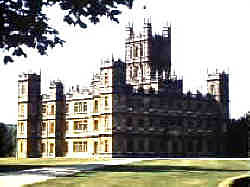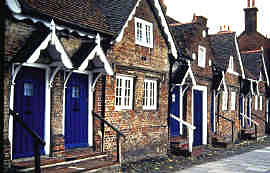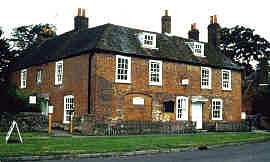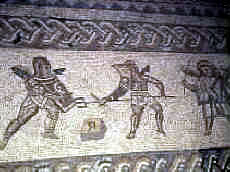HIGHCLERE TO BIGNOR |
|
Harlan Hague |
My trips to Britain always end in the Cotswold Hills, one of England's loveliest regions. In the early 1970s, I lived with my family at Chastleton, near Moreton-in-Marsh. We return often to visit friends and replenish the spirit.
Typically, we stay as long as possible and then rush to Heathrow or Gatwick for the flight home. One summer, I decided that my wife and I should make the departure more rewarding and planned a leisurely drive of two or three days to Gatwick.
Wantage was to be our first destination. We had stopped there briefly years ago, and I had warm memories of the town. We had strolled around the quiet square and had tea at the sunny church shop while our three girls made brass rubbings.Alas, Wantage was not as I remembered. The traffic was frantic, and I recognized nothing. So much for fond memories.
We drove toward Newbury, deciding to spend the night in the countryside. Miscalculation. The horses were running at Newbury, and there was no accommodation to be had for miles around. The manager at a village pub laughed when I asked about a room. She said that a local had been a big winner, and they were planning a great party for the night. She was not impressed with my suggestion that I contribute to the celebration as a guest at the pub.
We drove through Newbury southward and finally found a room at a pub in Burghclere. It was late, and the restaurant was crowded, but the clerk found us a table. The pub claims to have the best food in the south of England. If that is so, then I fear for the other eateries and their patrons.* It has been said that if one wishes to eat well in Britain, one must eat breakfast three times a day. Fried breakfast, that is. That's a lot of eggs, bacon, and fried toast. Actually, many B&Bs offer delicious non-fried breakfasts.
 We
visited Highclere Castle the next day. This marvelous country house,
hardly a castle, is included in only the newest guide books. It was
opened to the public in 1987 after the old Earl of Carnarvon died. The
new 7th Earl and Countess decided, quite understandably, that they would
prefer to continue living in a smaller house on the estate.
We
visited Highclere Castle the next day. This marvelous country house,
hardly a castle, is included in only the newest guide books. It was
opened to the public in 1987 after the old Earl of Carnarvon died. The
new 7th Earl and Countess decided, quite understandably, that they would
prefer to continue living in a smaller house on the estate.
The interiors and furnishings of the mansion reflect the influence of successive generations of the family since the beginnings of the house in the early eighteenth century. It is not by chance that the facade of the completed structure, with its pinnacles and carvings, reminds one of the Houses of Parliament. The architect, Sir Charles Barry, built both properties simultaneously. Calling his style Anglo-Italian, he liked Highclere Castle much the better of the two.
The 5th earl was the most famous of his line. He was the Carnarvon of Egyptian excavations in the Valley of the Kings and, with Howard Carter, the discoverer of the tomb of Tutankhamun in 1922. A collection of some of Carnarvon's Egyptian artifacts are on display in the basement of the house. The pieces were rediscovered by the present earl in 1987 in secret cubbyholes behind wall paneling. The artifacts were collected by the 5th earl in his early excavations, before 1922. They were missed when the 5th earl's widow sold the bulk of his Egyptian booty to the New York Metropolitan Museum.
After morning coffee or lunch at the pleasant Tea Rooms, see the horseracing exhibition in the basement. The Carnarvon family has been involved in breeding and racing for a hundred years. The present earl is racing manager to the Queen. Walk about the walled gardens and extensive park, partly landscaped by the legendary Capability Brown. ("This property shows capability," or something of the sort, Brown would say to prospective clients.) William Cobbett, the radical politician and author of Rural Rides, 1821, called it "the prettiest park that I have ever seen."
Leave Highclere and drive southeastward through Basingstoke to Odiham.
The village has a particularly handsome Georgian high street. Now drive southward past Alton to Chawton to visit Jane Austen's House. The
pretty seventeenth-century cottage was the novelist's home for the last
eight years of her short life, from 1809 to 1817. The house is
interesting as a memorial to the author, but also as a typical early
nineteenth century village home. She completed her best-known works
here, including Sense and Sensibility, Pride and Prejudice,
and Persuasion.
drive southward past Alton to Chawton to visit Jane Austen's House. The
pretty seventeenth-century cottage was the novelist's home for the last
eight years of her short life, from 1809 to 1817. The house is
interesting as a memorial to the author, but also as a typical early
nineteenth century village home. She completed her best-known works
here, including Sense and Sensibility, Pride and Prejudice,
and Persuasion.
Take refreshment at a pleasant little tea shop across the road. You can't miss it. Not all tourists are careful. A villager told me that he heard a noise in his sitting room one morning and investigated. There sat some Japanese who smiled up at him. "Tea . . . for five . . . please," the visitor said. The others looked on, pleasantly, expectantly. The villager smiled, and served them tea and biscuits. They drank their tea and munched on biscuits, chatting amiably. When they were finished, the leader paid, the five bowed, and they left.
You might find accommodation at the pub opposite the house. We looked
without success for a B&B in  the
tiny village and the surrounding countryside, settling finally for a
sterile motel miles away. We returned the next morning to visit the Jane
Austen House. It was not yet open, but the gracious publican made coffee
and toast for us. He said that he could have put us up last night,
though his rooms upstairs were being renovated. The situation was so
perfect that we thought of staying the next night.
the
tiny village and the surrounding countryside, settling finally for a
sterile motel miles away. We returned the next morning to visit the Jane
Austen House. It was not yet open, but the gracious publican made coffee
and toast for us. He said that he could have put us up last night,
though his rooms upstairs were being renovated. The situation was so
perfect that we thought of staying the next night.
But continue. Drive northeastward to Farnham, a small red-brick town with Georgian and half-timbered Tudor buildings. Rows of seventeenth-century almshouses and attractive cottages line a wide street that leads up to Farnham Castle. The view from the Norman keep is striking.
Continue south and east to Petworth. Stroll the narrow streets lined with old timbered houses. Seventeenth-century Petworth House contains one of the finest private art collections in Britain. The magnificent stately house and park, another of Capability Brown's creations, were favorite subjects of Turner, and several of his paintings hang in the house.
Drive southward now, carefully following signs, to Bignor. Pause in this hamlet of picturesque houses, some thatched and timbered, and look into the small thirteenth-century church. Continue eastward through rolling pasture and wheat fields to Bignor Roman Villa.
 The
Bignor villa was one of the largest farmsteads in Roman Britain. It was
positioned on Stane Street, a road linking coastal Chichester and
London. The site was first occupied late in the first century, but the
remains date mostly from the fourth century. The ruins were discovered
in 1811 and have been owned by the same family to the present day. The
ruins are enclosed in sturdy thatched buildings and are nicely
presented, not always the case with privately-owned ancient monuments.
The
Bignor villa was one of the largest farmsteads in Roman Britain. It was
positioned on Stane Street, a road linking coastal Chichester and
London. The site was first occupied late in the first century, but the
remains date mostly from the fourth century. The ruins were discovered
in 1811 and have been owned by the same family to the present day. The
ruins are enclosed in sturdy thatched buildings and are nicely
presented, not always the case with privately-owned ancient monuments.
The quality of the mosaics, some of the finest in Britain, proves the richness of the villa. An eighty-foot mosaic corridor is particularly notable. A piscina in an unheated summer dining room is decorated with mosaics of six dancing girls and a young Ganymede held in the talons of an eagle in flight. A winter dining room with underfloor heating has a wonderful mosaic of a woman, perhaps Venus, surrounded by long-tailed birds and circling vines. An adjacent rectangular panel shows winged cupids clothed as gladiators in various classic forms of combat.
Other mosaics depict the seasons, and another a dolphin with a signature, perhaps that of the designer of the mosaics. A separate structure protects the remains of the baths. A changing room, once heated by the subterranean hypocaust, contains a wonderful mosaic of Medusa with her swirling coiffure of snakes. The head is surrounded by intricate intertwining circles and geometrical designs.
Before leaving the villa, pause in the courtyard and look around. The pastures and cultivated fields probably look much as they did when the villa flourished. The land slopes gently down to the valley where the modern lane likely coincides with the Roman Stane Street. With only a little imagination, one can conjure up a busy farmstead of real people who lived and worked here fifteen centuries ago.
For general information, write or call well in advance the British Tourist Authority, 551 Fifth Avenue, New York, NY 10176, 212/581-4700. Ask specifically for materials on the region between Highclere Castle and Bignor Roman Villa. This inquiry will bring addresses that can provide more detailed information on particular attractions. The area is not overcrowded, and families should enjoy the excursion, even in summer.
*I have been advised by a local that the pub, the Carnarvon Arms, has since been sold and refurbished. Now the Carnarvon, the hotel serves excellent food at reasonable prices, the rooms are first-rate--and more expensive--and the staff is pleasant.
|
Caveat and disclaimer: This is a freelance travel article that I published some time ago. Some data, especially prices, links and contact information, may not be current. |
|
|
|
|